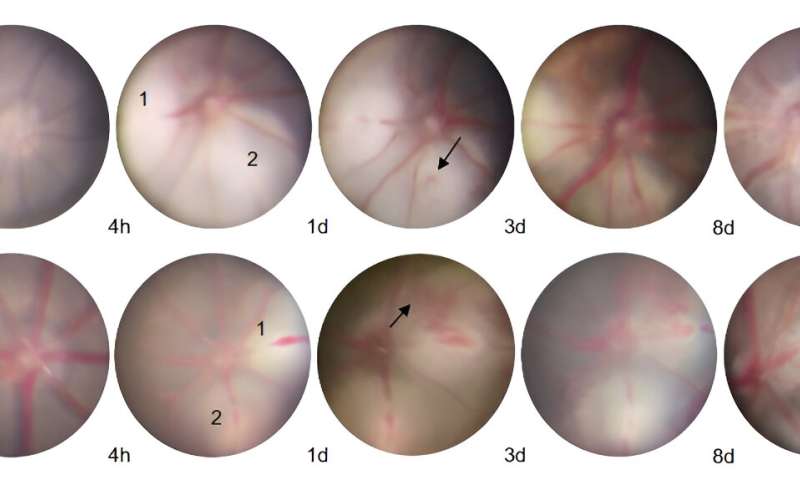The Protective Effect of DNase I in Retinal Vein Occlusion

Understanding retinal vein occlusion (RVO)
Retinal vein occlusion (RVO) is a critical eye condition, second only to diabetic retinopathy in prevalence among retinal vascular diseases. It occurs when one of the veins in the retina becomes blocked, leading to potential vision loss or blindness. This blockage often results in complications such as neovascular glaucoma and macular edema. Regular eye exams, especially for those with risk factors, are essential for the early detection and effective management of RVO.
The intriguing role of neutrophil extracellular traps in RVO
Recent research has uncovered a potential link between retinal vein occlusion (RVO) and neutrophil extracellular traps (NETs), a relatively recently discovered element of the body's immune response. NETs, web-like structures released by neutrophils (a type of white blood cell), play a crucial role in fighting infections.
NETs can exacerbate blockages in retinal veins by providing a structure for red blood cells and platelets to aggregate. This indicates that targeting NETs could be a promising approach in treating RVO. Additionally, excessive formation or inadequate degradation of NETs can lead to chronic inflammation, autoimmune diseases, and even cancer. Current research efforts are focused on understanding NETs to develop diagnostics and treatments for conditions where NETs are implicated.
In this study, 30 patients diagnosed with RVO were compared with 30 healthy individuals. The patients were carefully selected, ensuring they had no history of other thrombotic or systemic inflammatory diseases. The study analyzed various coagulation function parameters and NETs biomarkers, such as cell-free DNA (cf-DNA), myeloperoxidase-DNA (MPO-DNA), and neutrophil elastase (NE). These biomarkers are crucial indicators of NETs activity and can provide valuable insights into the relationship between NETs and RVO.
The senior author, Jun Zhang, from the Department of Ophthalmology, Changzhou Third People's Hospital, Changzhou Medical Center, Nanjing Medical University, Changzhou, China, explained that the study also extended to animal models, where an RVO mouse model was created using retinal laser therapy. The mice were divided into groups, with some receiving DNase I injections and others serving as controls. This setup allowed for a detailed examination of how DNase I affects NETs formation and the progression of RVO. The analysis included retinal imaging, blood sample collection, and histological evaluations to assess the impact of DNase I on the retinal vessels.
DNase I: A potent NETs inhibitor
Deoxyribonuclease I (DNase I) emerges as a focal point in this research. This enzyme, known for its ability to degrade DNA, acts as a natural inhibitor of NETs. DNase I's role in medical treatments has been underutilized despite its potential benefits, particularly in vascular diseases. In this study, DNase I was explored as a therapeutic agent to mitigate the effects of NETs in RVO. The hypothesis was that by breaking down the DNA in NETs, DNase I could prevent the formation of blood clots in the retina.
The results were interesting. Both human and mouse models showed increased levels of NETs biomarkers in cases of RVO. The administration of DNase I in the mouse model led to a significant reduction in these biomarkers. More importantly, DNase I shortened the duration of retinal thrombus in the RVO mice. These findings were corroborated by immunofluorescence images and Western blot analysis, which showed a decrease in NETs-related markers post-DNase I treatment.
The first author, Guohua Deng, from the Department of Ophthalmology, Changzhou Third People's Hospital, Changzhou Medical Center, Nanjing Medical University, Changzhou, China, empahised that the study positions DNase I as a promising candidate for the treatment of RVO, particularly due to its effectiveness in reducing NETs formation and the duration of retinal thrombus. This represents a potential shift in the therapeutic approach to RVO, moving from merely managing complications to addressing one of the primary underlying causes of the condition. Further studies are crucial to thoroughly understand the role of DNase I and to establish a foundation for its integration into clinical treatments for RVO.
More information:
Guohua Deng et al, The protective effect of DNase I in retinal vein occlusion, Biomolecules and Biomedicine (2023). DOI: 10.17305/bb.2023.9780
Provided by Association of Basic Medical Sciences of FBIH